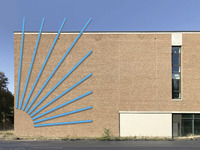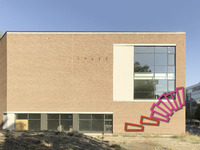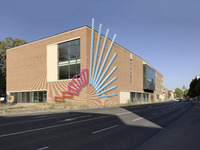























































































At the end of January 2021, the proposal “Archäo-Logik” (Archaeo-Logic) was submitted to the art-for-architecture competition for the Archäologiezentrum in Mainz, for which tenders were invited from across Europe. The façade of the building that houses both the research centre and the museum is to receive an artistic design with the character of a signature and with impact on the urban environment.

for the east wall
21-02-002

for the south wall
21-02-001

21-02-003
Archaeology reveals traces – traces of human creation, activity and thought. In this way it reveals knowledge – knowledge that is timeless and that constitutes resources for the future. We do not draw on the traces, but on the ideas that are founded on the traces.
This explanation is the content of the art concept “Archäo-Logik” and is made evident by its visual implementation. The motif of the round arch, a Roman invention, serves as an example of knowledge that has been handed down: many things come together to fulfil one purpose. In short: the interaction of forces. The visualisation shows this doubly: one the one hand, as a pictorial suggestion, the composition of a round arch; on the other hand, as an abstract quote – interaction and diversity.
This on the one hand/on the other hand is spatially allocated to the two façades of the building. The edge of the building is the hinge between a retrospective view into the past and the forward-looking present. In this way, the edge of the building acquires meaning. It becomes a theme: today, the boundary between yesterday and tomorrow.
The edge of the building displays the following features in mutual opposition:
on the left, the colour of life; on the right, the colour of the horizon. On the left, enclosure within the surface of the façade; on the right, the surpassing of the height of the façade. On the left, the naturally determined contour of the individual part; on the right, the geometrical contour of the rectangle. On the left, centripetal concentration; on the right, centrifugal unfolding. On the left, the concrete representation; on the right, the abstract vision. But also vice-versa: on the left, abstract imagination (the nature of the surface); on the right, the concrete substance (sculptural depth).
The edge of the building is not only a caesura, but also a topos of connection. As a joint, it brings the pictorial antitheses together and makes it possible for them to be experienced through contrast. It compels the left and the right to relate to each other. In this way it creates a symbiosis of opposites. Above all, it represents the zenith of a bridging (Mainz is a city of bridges). It joins two arch segments to form a complete arch.







































































































































































































